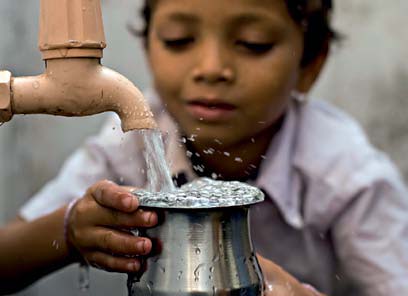 This report by the Water and Sanitation Program of the World Bank provides an account of the field level initiatives on drinking water security in India. The country faces many challenges in ensuring reliable, sustainable safe drinking water supply to rural households.
This report by the Water and Sanitation Program of the World Bank provides an account of the field level initiatives on drinking water security in India. The country faces many challenges in ensuring reliable, sustainable safe drinking water supply to rural households.
Though, in terms of provision of safe drinking water, more than 90 percent of the rural households have been covered, according to the NSSO 65th round survey 2008-09, much remains to be done to improve levels of service delivery, water quality and sustainability.
Though chemical contamination of drinking water is being tackled today in National Rural Drinking Water Programme (NRDWP), bacteriological contamination, which is more dangerous and also more prevalent has to be systematically measured and tackled. This requires convergence with the Total Sanitation Campaign (TSC) to ensure an open defecation free and clean environment.
Slightly more than 30 percent of rural households obtain their drinking water supply through taps which are more convenient, saving time and labour specially of women and children. However, this varies widely ranging from less than 5 percent in Uttar Pradesh and Bihar to more than 80 percent in Tamil Nadu and Himachal Pradesh.
A large number of successful models of providing sustainable and safe drinking water have been tried out throughout the country. These are built on traditional experience and also chart out new paths using the latest technologies and innate wisdom of the people.
Though conditions vary widely among the states, in today’s globalized world where countries learn from one another, there are many lessons that states and regions of the countries can learn from each other. Experts and practitioners in the field of rural water supply are aware of many good practices that have succeeded and sustained in different parts of the country. With the help of Water and Sanitation Program, the Department of Drinking Water and Sanitation has collected some models of good practices from different parts of the country. Care has been taken to ensure these are drawn from as many states as possible.
In addition, the good practices identified cover a variety of areas ranging from improved service delivery, operation of multi-village schemes, efficient operation and maintenance, ensuring water quality, measures to ensure source sustainability, pioneering efforts for waste water management, effective communication practices that have been adopted and institutional reforms at state level that have been tried out.
It can be seen from these case studies that local governments, through community participation, have been able to provide 24x7 water supply to save women’s time, water and energy cost, install household connections with meters to provide each and every one with an adequate service and achieve financial sustainability, entrust independent bodies to take care of operation and maintenance, develop efficient water taxes collection, learn from one another to improve their management practice, increase consumer voices and service providers accountability, and manage multi-villages schemes.
Water quality can also be tackled, by ensuring an open defecation free environment, empowering communities to develop water safety plans and protecting their sources and develop partnership with the private sector for providing purified water for drinking purpose at affordable price.
Achieving sustainable aquifers is possible with community participation, traditional technology, science and demand management. The ground water table can be increased by 20 to 50 feet, dead rivers could be brought back to life and dark zones brought back to white zones.
The report is divided into seven sections – (i) Improved Rural Water Supply Service (ii) Multi-Village Scheme Innovations (iii) Water Quality (iv) Source Sustainability (v) Waste Water Management (vi) Communication for Water and (vii) State Level Reforms.
Download the report here -





 Towards_drinking_water_security_in_India_Lessons_from_the_field_WSP_2011.pdf
Towards_drinking_water_security_in_India_Lessons_from_the_field_WSP_2011.pdf







